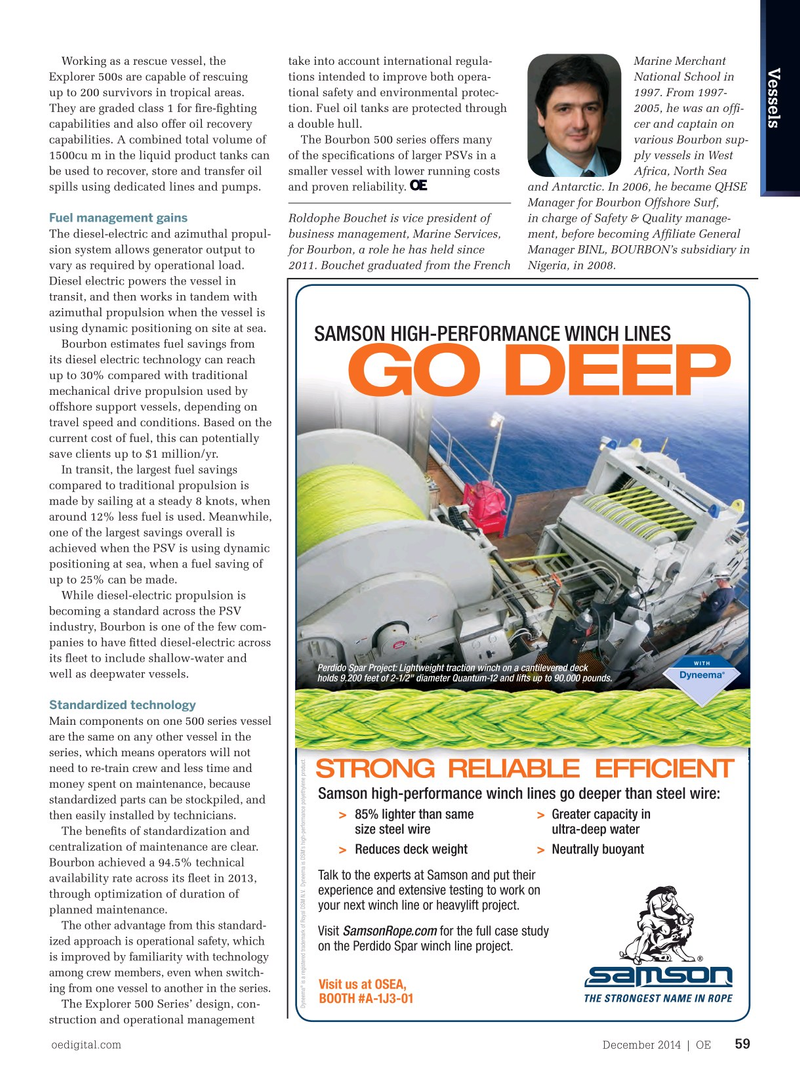
Page 57: of Offshore Engineer Magazine (Dec/Jan 2014)
Read this page in Pdf, Flash or Html5 edition of Dec/Jan 2014 Offshore Engineer Magazine
Working as a rescue vessel, the take into account international regula- Marine Merchant
Vessels
Explorer 500s are capable of rescuing tions intended to improve both opera- National School in up to 200 survivors in tropical areas. tional safety and environmental protec- 1997. From 1997-
They are graded class 1 for ? re-? ghting tion. Fuel oil tanks are protected through 2005, he was an of? - capabilities and also offer oil recovery a double hull. cer and captain on capabilities. A combined total volume of The Bourbon 500 series offers many various Bourbon sup- 1500cu m in the liquid product tanks can of the speci? cations of larger PSVs in a ply vessels in West be used to recover, store and transfer oil smaller vessel with lower running costs Africa, North Sea spills using dedicated lines and pumps. and proven reliability. and Antarctic. In 2006, he became QHSE
Manager for Bourbon Offshore Surf,
Fuel management gains
Roldophe Bouchet is vice president of in charge of Safety & Quality manage-
The diesel-electric and azimuthal propul- business management, Marine Services, ment, before becoming Af? liate General sion system allows generator output to for Bourbon, a role he has held since Manager BINL, BOURBON’s subsidiary in vary as required by operational load. 2011. Bouchet graduated from the French Nigeria, in 2008.
Diesel electric powers the vessel in transit, and then works in tandem with azimuthal propulsion when the vessel is using dynamic positioning on site at sea.
SamSon high-performance winch lineS
Bourbon estimates fuel savings from its diesel electric technology can reach up to 30% compared with traditional
Addressing the changing needs mechanical drive propulsion used by
GO DEEP offshore support vessels, depending on travel speed and conditions. Based on the current cost of fuel, this can potentially save clients up to $1 million/yr. products and can also be used to load mud
In transit, the largest fuel savings with high pollution and safety hazards. compared to traditional propulsion is
The presence of three separate lines made by sailing at a steady 8 knots, when going into the liquid product tanks adds around 12% less fuel is used. Meanwhile, ? exibility, allowing easy loading of base one of the largest savings overall is oil, drilling mud, brine or methanol in achieved when the PSV is using dynamic different tanks. positioning at sea, when a fuel saving of
In the past, there was a tendency to keep up to 25% can be made. all liquids in dedicated tanks. However,
While diesel-electric propulsion is
Bourbon, in common with the wider PSV becoming a standard across the PSV sector, added ? exibility to its tank technol- industry, Bourbon is one of the few com- ogy over the years to ensure that tanks can panies to have ? tted diesel-electric across now handle a variety of liquids, if the need its ? eet to include shallow-water and
Perdido Spar Project: Lightweight traction winch on a cantilevered deck arises. This adds to the potential capacity well as deepwater vessels.
holds 9,200 feet of 2-1/2" diameter Quantum-12 and lifts up to 90,000 pounds. holds 9,200 feet of 2-1/2" diameter Quantum-12 and lifts up to 90,000 pounds. holds 9,200 feet of 2-1/2" diameter Quantum-12 and lifts up to 90,000 pounds. available for some liquids, such as mud.
Standardized technology
Light subsea capability Main components on one 500 series vessel
Another development re? ecting the are the same on any other vessel in the changing requirements of the offshore series, which means operators will not industry is Bourbon’s decision to equip need to re-train crew and less time and
STRONG RELIABLE EFFICIENT every vessel in the Explorer 500 series money spent on maintenance, because
Samson high-performance winch lines go deeper than steel wire: with the infrastructure necessary to take a standardized parts can be stockpiled, and > 85% lighter than same > greater capacity in crane of up to 50-tonne. This helps make then easily installed by technicians. size steel wire ultra-deep water the Explorer 500s ? exible multi-purpose The bene? ts of standardization and support vessels, and easily upgradable to centralization of maintenance are clear. > reduces deck weight > neutrally buoyant provide ROV support and handle light Bourbon achieved a 94.5% technical
Talk to the experts at Samson and put their subsea intervention work. They are also availability rate across its ? eet in 2013, experience and extensive testing to work on ready to accommodate the High Precision through optimization of duration of your next winch line or heavylift project.
Acoustic Positioning (HIPAP) system to planned maintenance.
The other advantage from this standard- facilitate these operations. The Explorer
Visit SamsonRope.com for the full case study ized approach is operational safety, which 500 series has accommodation for 50 on the Perdido Spar winch line project.
is improved by familiarity with technology people in two main cabins, holding 19 among crew members, even when switch- people each, and 12 single cabins, all ®
Visit us at OSEA, ing from one vessel to another in the series. ranked comfort class 3. The vessel has a
BOOth #A-1J3-01 large deck space, totaling 714cu m and The Explorer 500 Series’ design, con-
Dyneema is a registered trademark of Royal DSM N.V. Dyneema is DSM’s high-performance polyethylene product.Dyneema is DSM’s high-performance polyethylene product.Dyneema is DSM’s high-performance polyethylene product.
Class 2 dynamic positioning. struction and operational management oedigital.com December 2014 | OE 59 058_OE1214_Vessels4_Bourbon.indd 59 11/21/14 1:00 PM

 56
56

 58
58